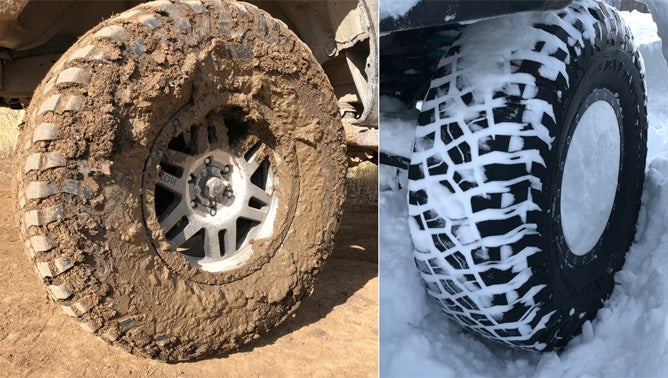With all-around capabilities and an above average lifespan, the BFGoodrich KM3 may be the everyday mud-terrain that drivers have long been hoping for.
A Sibling Rivalry Among Tires
When your big brother is a legend, he looms over you. Whether present or absent, you feel him watching from somewhere just behind. So little brothers grow up with big expectations, even a chip on their shoulder.
But when your big brother is a rock star, your only hope is to shine in a new arena. In the BF Goodrich family, the legendary All-Terrain is the sibling that looms large. Released in 1976, the AT single-handedly defined a tire category, and rewrote what toughness meant in 4×4 tires through its wins at Baja. Its iconic status was cemented with the much heralded (and now widely celebrated) 4th generation in 2015. Selling over 1 million tires in only eight months following release, the KO2 is the tough, refined, popular and good-looking big brother that sets the bar against its siblings (and rivals) are measured.
As enduring as it is, BFG’s Mud Terrain is still the little brother to the KO2. Yet in 1980, when initially released, it grabbed the headlines. And then did so again only four years later when released as the first-ever 35” light truck tire.
Brothers completing to prove who’s toughest. That’s the BFG story of KM vs KO tires. The brand’s two leading off-road tires have played leapfrog as one, then the other, takes the stage and steals the limelight. Despite the KO2’s tremendous success—or because of it—the release of the BFGoodrich KM3 was highly anticipated. That’s putting it mildly. The previous 4th generation KM2 had appeared in 2007, and in the 11 years since then tire tech had markedly progressed, leaving the design in need of a refresh.
Table of contents
Mud-terrain Evolution
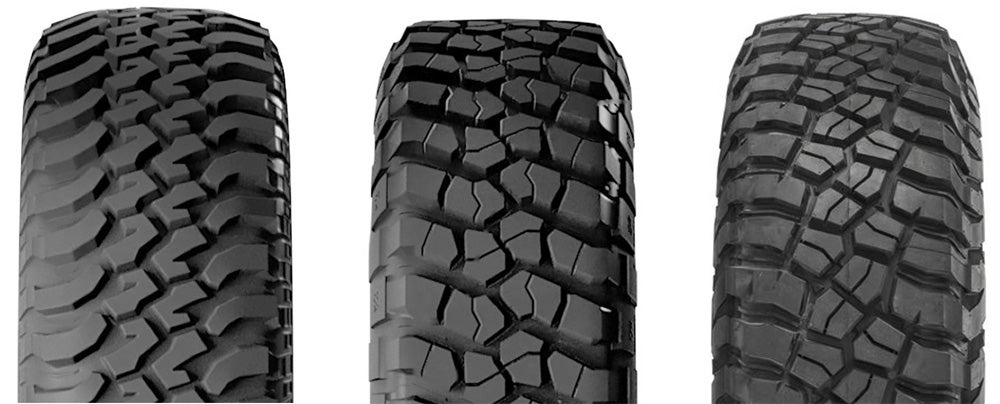
Breaking the mold of the KM2 wasn’t needed, and would have been ill-advised. The KM2 has had an enormous following. Wisely, BFG engineers opted for only a modest evolution in the pattern of the tire. That said, the BFGoodrich KM3 is clearly bred from the KM2. As a side-by-side comparison shows, they share a lot of similarities, though the KM3 tightens up voids between blocks by ~10%. Sound heretical for a mud-terrain? We pondered the same question.
Tread depth remains generally unchanged in sizes shared by both the KM2 and KM3, though the D-rated 37×12.5r17 dropped from 20/32” to 18/32”. This is surprising, and seems to defy logic, unless a more all-around MT was a goal the design team faced. Like most MT designs, the new BFGoodrich KM3 lacks siping, instead providing actual tread voids within the central blocks. The larger, primary voids are fully equipped with specially designed features for helping guard from rock drilling and to dislodge build-up of mud, snow and sand. Despite these changes, the big news is evolution within the tire’s construction. And the grip story goes deep with the KM3.
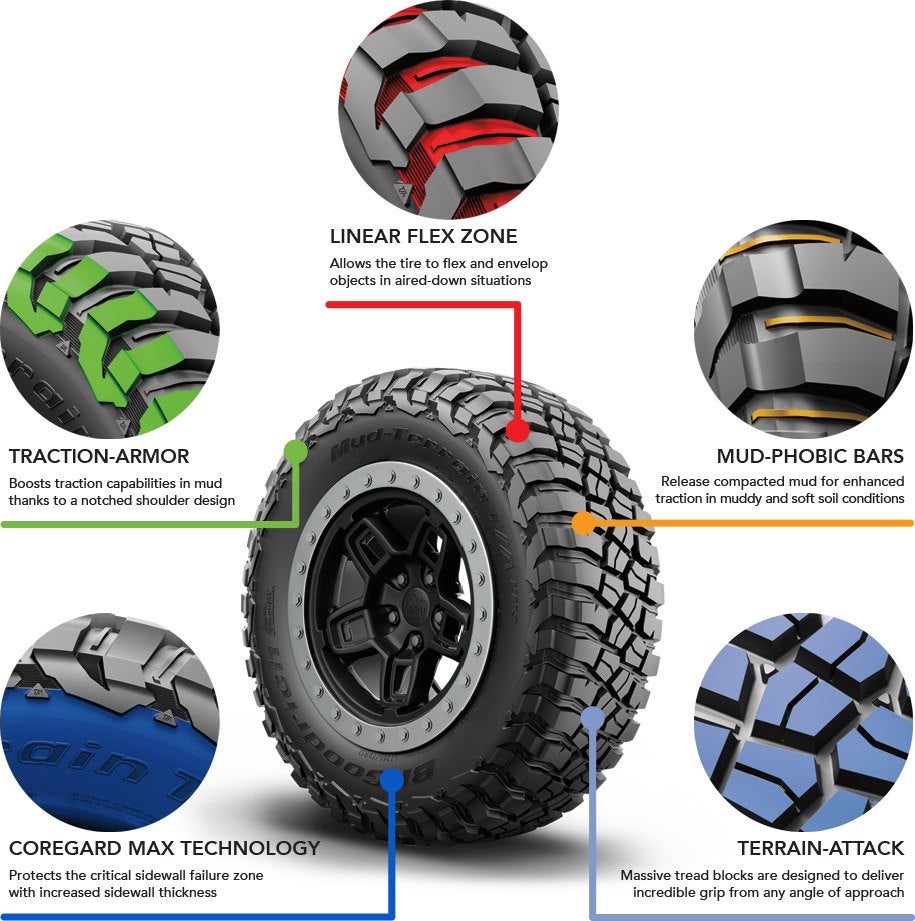
The BFGoodrich KM3’s carcass was engineered to conform more effectively to irregular surfaces when aired down. The brand’s so-called Linear Flex Zone is a design priority that pre-dates the KM3, but BFG divulges no secrets about how it achieves the balance between pliability and puncture resistance. Nonetheless, the results speak for themselves, with the tire behaving like to a rock climbing slipper once psi is dropped sufficiently.
For those who play in the rocks, this characteristic is one reason why the KM3 has been so well-received. The tire grabs aggressively thanks to both its tread (somewhat painfully hyped as “Terrain-Attack”) and this carcass conformity. BFG tackled the related fear of sidewall damage that accompanies lowered tire pressures, assuring these flex capabilities can be safely used by owners. This combination of improvements is most attributable to three characteristics: rubber compound resistance to penetration, increased shoulder protection (e.g., enlarged shoulder blocks vs. KM2), and thicker 3-ply sidewalls.
The latter, termed CoreGard Max, is another example of the real-world torture testing that BFG still maintains through its ongoing commitment to desert racing. That brutal sport was where CoreGard Max was initially proven, with the Baja T/A KR3 being the latest iteration of the race tires it appears in. Watching the Mint 400 in 2018 I was reminded why it’s so impressive that BFG has consistently produced the most dominant tires (9 of 10 category wins) in top races. Putting out 500-900hp, SCORE trucks flog tires like no street 4×4 ever will. For consumers that means tires like the BFGoodrich KM3 are incorporating design safeguards that exceed most of our worst-case-scenarios.
Out on the Trail
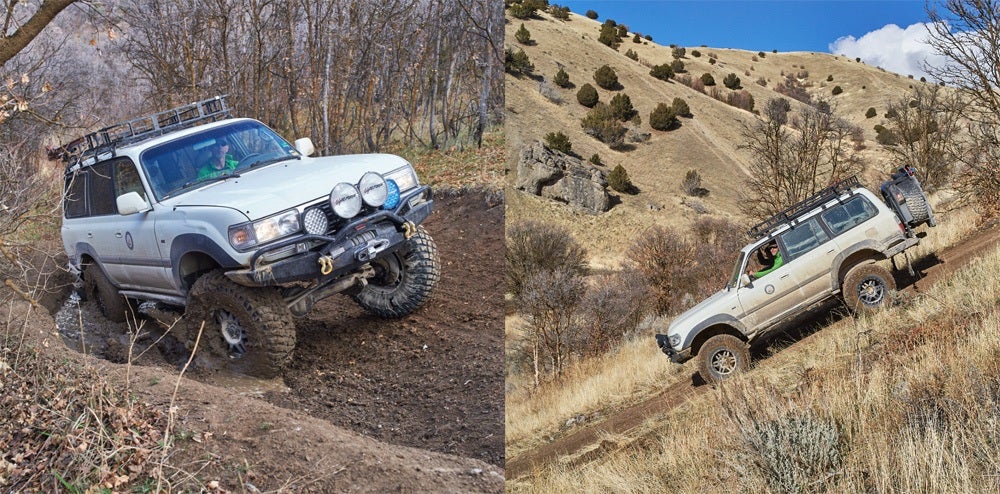
After a year of crawling, towing, airing down, surpassing speed limits, and desert exploring, our BFG KM3 test tires are extraordinarily devoid of chipping, tears or cuts. There has been zero chipping or tears in the main tread blocks. What little damage did occur was only found among the sidewall blocks, with missing pieces larger than 3/8” width, and cuts measuring ~1/4”. While by no means a powerful truck, a fully built Land Cruiser is as heavy as many diesels.
Wear of the BFGoodrich KM3’s shoulder blocks has proven typical for a 3-ton+ rig riding atop a 6” lift that is routinely charging up canyons on twisty pavement to reach the backcountry. But the decline typical for a mud-terrain has been noticeably lower with the KM3 than other brands we have run on the same Cruiser. Cupping and other irregularities haven’t appeared, and road noise has been unchanged. As expected, the premium grade quality that BFG has built its brand on shows through in this tire.

Field reports from long-term overlanders running the BFG KM3 in Australia and elsewhere overseas have confirmed the tire’s performance across thousands of kilometers of desert and bush. Many of those reports sing praises especially of the tire’s resistance to cuts and punctures, along with its noteworthy behavior on sand. MT’s are generally too aggressive on sand, especially the dry variety, as they claw downward instead of pulling forward. Perhaps due to the modestly tighter tread blocks, the KM3 seem less inclined to dig.
To pit the BFGoodrich KM3’s against very dry and sugary sand we drove to central Utah and the mile upon mile of dunes composing the BLM’s Little Sahara Recreation Area. Sized in a 37×12.50r17, a drop to only 22/25psi (ft/rr) yields immediately hook up. Whether this is more attributable to how the carcass reshapes to the terrain, or to the tread pattern is unknowable. Regardless, the outcome is what you’d hope for if sand tracks, washes or dunes are where you venture.
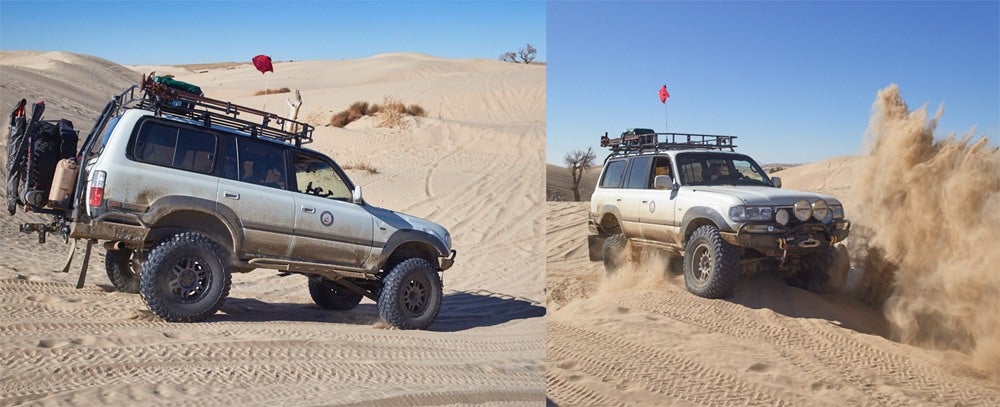
Wintertime use was often said to reveal the main weakness in the KM2. In deeper snow its performance was reasonable, improving over AT’s as depth of the white stuff increased. But on packed snow or ice they resembled hockey pucks. These general tendencies are unchanged with the BFG KM3. However, I take issue with the hockey reference; while the KM3’s performance in such conditions isn’t on par with Interco’s Trxus (the best MT we have run for winter roads and trails), it’s by no means scary.
If you need a tire largely for winter pavement then choosing an MT doesn’t make sense, whether it’s the BFG or any other make. The massive blocks inherent in their design can’t compete with siped tires. But in deeper conditions the BFGoodrich KM3 claws through as you would hope, particularly after aired down to psi levels in the teens. In 12-18” of snow the tire pulls well, though its voids pack more than is ideal (likely a result of the tighter lug spacing)
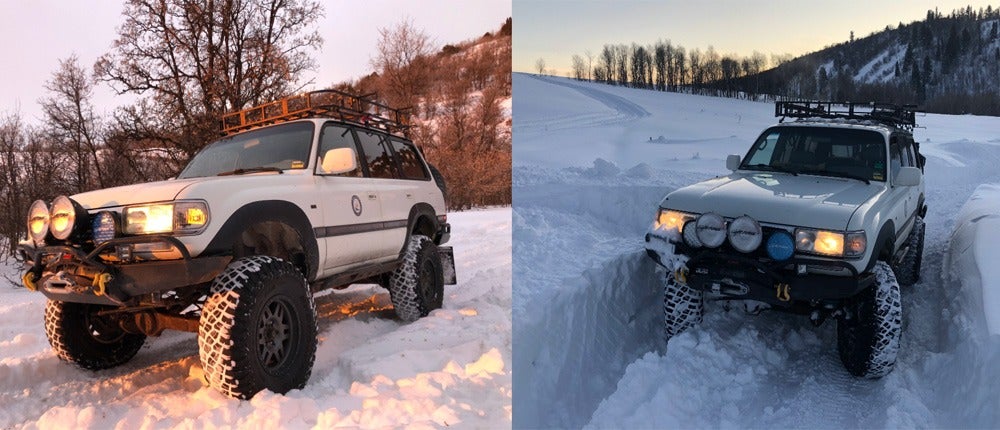
When surfaces turn wet, the tire’s improved Krawl-TEK rubber compound offers improvements over the prior rubber formula. Whether on pavement or rock, the BFG KM3 tires provided no “grip drama.” Their handling and adhesion are predictable and confidence-inspiring without feeling spongy.
Lifespan for mud-terrain tires is not one of their selling points. Some are worse than others. The BFGoodrich KM3 is touted as having a tougher sidewall, but the manufacturer makes no claims about improved wear over the KM2. In our testing, 5,500 miles of use on mixed surfaces resulted in 2/32” of wear. According to the majority of state DOT regulations, when only 2/32” of tread remains a tire is no longer legal. At that rate, it may be possible for KM3 owners to get 44,000 miles of use. Most owners will replace sooner, so estimating 30-40,000 miles would be wise.
It’s a sign of the times that an iconic mud-terrain tire is, today, released in sizes and for applications never dreamed of in 1980 when the T/A MT first emerged. Spanning 15” through 20” wheels, and 30-39” diameters, BFG has provided a wide range of options. More uniquely, the company has seen the light, and is producing a unique UTV-version of the KM3.
Icon Vehicle Dynamics’ SIX SPEED Wheel
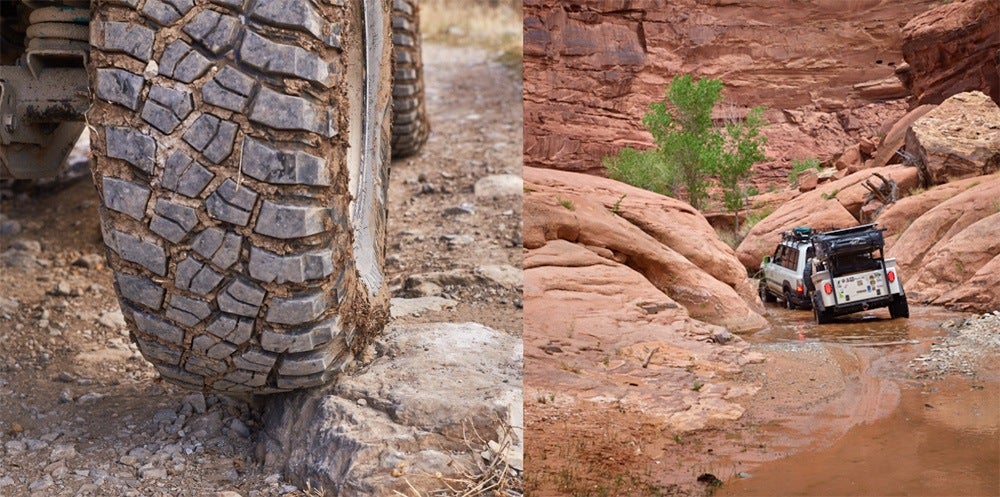
New tires are best served up atop new rims. Suspension specialists Icon Vehicle Dynamics began offering high-end alloy wheels to complement their line of high-end suspension lifts in 2015. Unlike most wheels, theirs were spec’d with proper backspacing to reduce scrub radius, and provide un-hindered suspension travel for applications in what they call “ICON-optimized” configurations. To help resolve this, their wheels are precisely designed to pair with vehicle suspensions, especially several Toyota fitments.
We worked with Icon’s Tyler West to properly select wheels for the 37” KM3s on the 80 Series Toyota. The SIX SPEED, released in 2016, was chosen for its offset. Its design pays visual tribute to race versions of the wheel, which feature full beadlocks in a forged construction. Those wheels have been raced on by Ultra 4 athlete Tom Wayes, as well as Lucas Oil Pro 2 racer and Supercross legend Jeremy McGrath.
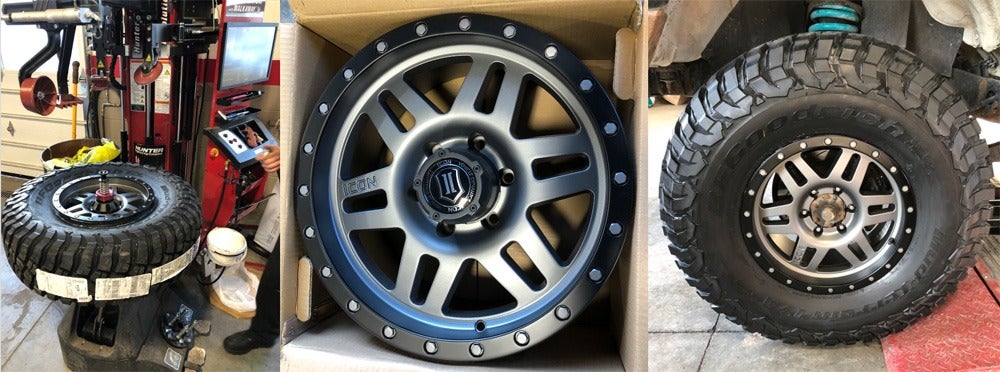
Icon Alloys are a fairly subdued look in a day when bling seems to be the popular style for 4×4’s. Race inspired in strength and appearance, models like their SIX SPEED, ALPHA and REBOUND utilize spoked construction, and tough finishes. They also are designed with the larger brake rotors of today’s vehicles in mind, maximizing caliper clearance.
Icon Alloys are within normal weight range for quality trail-ready wheels, averaging ~30 lbs apiece. Load range, which buyers often overlook, for various Icon rim styles vary from 1600 lbs to 4000 lbs. The SIX SPEED is generously rated at 2500 lbs, which is more than adequate. Offered in five matte colors, they’re easy to visually pair up with most any rig.
Properly pairing of tire and wheel is easily overlooked, but puts a major investment in new tires at risk. Enabling perfect tire profile for the 12.50-sized BFGoodrich KM3’s, Icon’s 17×8.5 rims enable full-width, even tread wear and, at reduced psi’s, the full contact patch afforded by BFG’s Linear Flex Zone. Mounted with the latest equipment from Hunter Engineering at Big O Tires, the wheel/tire combo only required an average of ~5oz to dynamically balance.
Since their mounting, the SIX SPEED’s have proven their quality. The finish remains flawless, and scratches are non-existent. The only fault we found with the wheels lies with the beadlock-esque trim. The ring will, in thick mud, tend to capture the muck and hold it there with centrifugal force. This minor annoyance is mostly irrelevant in regular use, as a pressure washer bath should follow any trail time, and easily frees the trapped mud.
Our Final Verdict
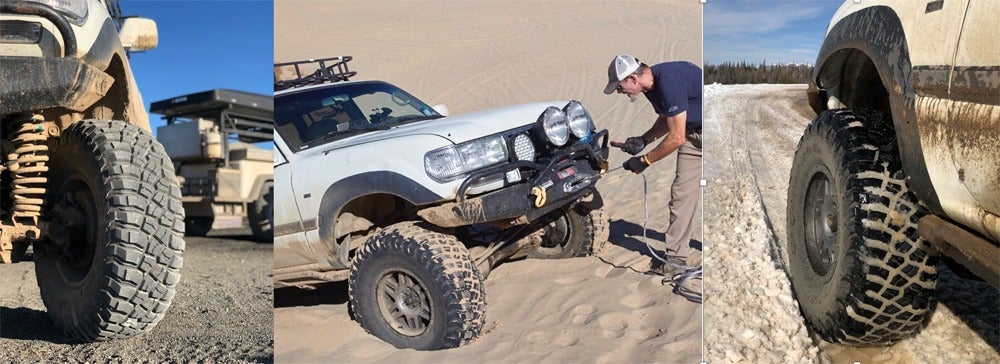
Mud-terrain tires, since their introduction in the 1970s, have earned a reputation for being off-road specific. Unlike any MT we’ve run before, the BFGoodrich KM3 has yielded performance that very nearly makes it an everyday tire. As good as the KO2 is, the BFG KM3 is more similar in pavement manners than you’d expect, and yet offers significant trail handling improvements. This comparison is remarkable. Held to be one of today’s very best 4×4 tires, the KO2 presents a high bar to meet, let alone exceed.
For drivers who aren’t in need of a tire with the K02’s performance in snow and ice, the BFG KM3 is a tough yet (believe it or not) fairly quiet alternative that may let them leapfrog AT designs for (almost) the most aggressive DOT-approved model from BFGoodrich*. With all-around capabilities and an above average lifespan, it may be the everyday mud-terrain that drivers have long been hoping for.
We are committed to finding, researching, and recommending the best products. We earn commissions from purchases you make using the retail links in our product reviews. Learn more about how this works.
About the Gear Doctor: Dr. Sean Michael has been designing, abusing and testing outdoor gear since the 1980’s, and began reviewing products for Off-road.com in 2000. Today, he is Professor of Outdoor Product Design & Development at Utah State University, a product consultant, and a frequent Instructor at Overland Expo. Follow his trips and gear abuse @thegeardoctor on Instagram.
Special Thanks to the team at Big O Tires in Logan and Providence, UT, for their generous support and technical assistance with this and other Gear Doctor reviews.
*BFG’s Krawler KX-Blue Label remains the gnarliest offering from the company, but is only a notch away from being a full competition tire, though it does carry a DOT sidewall stamp.
